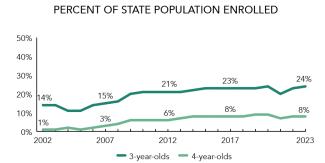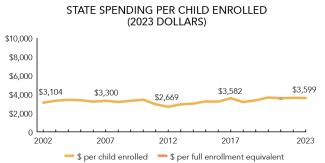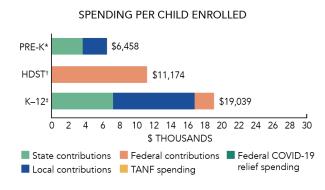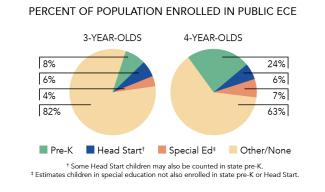
State of Preschool
Colorado
Access Rankings
Resource Rankings
Total Benchmarks Met
Overview

During the 2022-2023 school year, Colorado preschool enrolled 21,340 children, an increase of 873 from the prior year. State spending totaled $76,799,772, up $2,734,837 (4%), adjusted for inflation, since last year. State spending per child equaled $3,599 in 2022-2023, down $20 from 2021-2022, adjusted for inflation. Colorado met 4 of 10 quality standards benchmarks.
What's New

The passage of Proposition EE in November 2020, and related laws (e.g., HB22-1295) passed in 2021 and 2022, established the Department of Early Childhood (CDEC). The new statewide universal preschool program launched July 1, 2023, at which time the Colorado Preschool Program sunsetted. The new program, which is not covered in this report this year, is administered by the CDEC using a mixed delivery model, and in collaboration with Local Coordinating Organizations rather than local school districts. The Colorado Department of Education will continue to administer federal and state funding for special education in accordance with IDEA and Exceptional Children’s Educational Act (ECEA) for children ages three through five.
CDEC received a $3,971,588 Preschool Development Grant Birth through Five (PDG B–5) in December 2022. Colorado Shines Brighter (PDG B–5) is based on the state’s shared vision to ensure all children are ready for school when entering kindergarten by achieving three outcomes: Colorado families have access to quality formal early childhood care and education settings of their choosing which best meet the needs of their child and family, especially those who are vulnerable and infants and toddlers; informal early childhood care and education environments (parental, friend, family, and neighbor care) are enhanced to enrich and support children’s physical, social, emotional, and cognitive development; and Colorado’s B–5 early childhood state system is coordinated and aligned to enhance the resources available to families and to improve the quality of relationships among families, caregivers, and children.
Background
The Colorado Preschool Program (CPP) launched in 1988 for 4-year-olds who needed language development support, in hopes of lowering school dropout rates and reducing dependence on public assistance. In 1992, CPP became a permanent program and expanded eligibility to young children lacking overall school readiness due to family risk factors, as defined by statute (e.g., eligibility for FRPL, dual language learners, in foster care, family history of abuse or neglect, homelessness, parental substance abuse, or teen parent, as well as locally determined risk factors). Four year-olds must meet at least one risk factor to enroll in CPP, while 3-year-olds are required to meet a minimum of three risk factors. Three districts also serve a limited number of children under the age of three using a waiver that is no longer statutorily available. The data in this report only pertains to children aged three and up.
In the 2021-2022 school year, 98% of the state’s 179 school districts offered CPP. Districts reapply annually to implement CPP. CPP funding is determined by the Colorado school finance formula, with preschoolers receiving half the amount for students in grades 1 through 12, and significant funds included in the financing formula from local school tax revenues. Funds are distributed directly to school districts, each receiving a base allocation from the Colorado Department of Education of half-day positions to serve eligible children. Schools may provide pre-K service by subcontracting with private childcare centers, Head Start, or other community-based or public agencies. CPP providers are encouraged to use additional funding sources, such as federal Head Start money, tuition, or local funds, to extend the program day, supplement services, or provide wraparound care.
Colorado Preschool Program
Access
Resources
| Total state pre-K spending | $76,799,772 |
| Local match required? | Yes |
| State Head Start spending | $0 |
| State spending per child enrolled | $3,599 |
| All reported spending per child enrolled* | $6,458 |

*Pre-K programs may receive additional funds from federal or local sources that are not included in this figure. †Head Start per-child spending includes funding only for 3- and 4-year-olds. ‡K–12 expenditures include capital spending as well as current operating expenditures.
Colorado Quality Standards Checklist
| Policy | Requirement | Benchmark | Meets Benchmark? |
|---|---|---|---|
For more information about the benchmarks, see the Executive Summary and the Roadmap to State pages. | 4benchmarks met | ||
| Early Learning & Development Standards Benchmark | Comprehensive, aligned, supported, culturally sensitive | Comprehensive, aligned, supported, culturally sensitive | |
| Curriculum Supports Benchmark | Approval process | Approval process & supports | |
| Teacher Degree Benchmark | Early Childhood Teacher Qualification | BA | |
| Teacher Specialized Training Benchmark | Early Childhood Teacher Qualification | Specializing in pre-K | |
| Assistant Teacher Degree Benchmark | None | CDA or equivalent | |
| Staff Professional Development Benchmark | 15 hours/year | For teachers & assistants: At least 15 hours/year; individual PD plans; coaching | |
| Maximum Class Size Benchmark | 16 (3- & 4-year-olds) | 20 or lower | |
| Staff to Child Ratio Benchmark | 1:8 (3- & 4-year-olds) | 1:10 or better | |
| Screening & Referral Benchmark | None | Vision, hearing & health screenings; & referral | |
| Continuous Quality Improvement System Benchmark | Structured classroom observations (above QRIS Level 2); Data used for program improvement | Structured classroom observations; data used for program improvement | |
